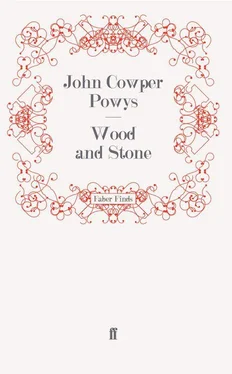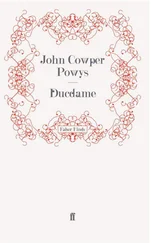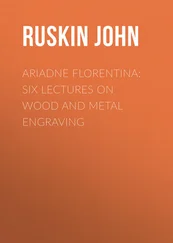East of the hill, nestling at the base of a cone-shaped eminence overgrown with trees and topped by a thin Thyrsus-like tower, lies the village of Nevilton.
Were it not for the neighbourhood of the more massive promontory this conical protuberance would itself have stood out as an emphatic landmark; but Leo’s Hill detracts from its emphasis, as it detracts from the emphasis of all other deviations from the sea-level, between Yeoborough and the foot of the Quantocks.
It was on the apex of Nevilton Mount that the Holy Rood of Waltham was first found; but with whatever spiritual influence this event may have endowed the gentler summit, it is not to it, but to Leo’s Hill, that the lives and destinies of the people of Nevilton have come, to gravitate. One might. indeed without difficulty conceive of a strange supernatural conflict going on between the consecrated repository of Christian tradition guarding its little flock, and the impious heathen fortress to which day by day that flock is driven, to seek their material sustenance.
Even in Pre-Celtic times those formidably dug trenches and frowning slopes must have looked down on the surrounding valley; and to this day it is the same suggestion of tyrannical military dominance, which, in spite of quarries and cranes and fragrant yellow gorse, gives the place its prevailing character.
The rounded escarpments have for centuries been covered with pleasant turf and browsed upon by sheep; but patient antiquarian research constantly brings to light its coins, torques, urns, arrow-heads, amulets; and rumour hints that yet more precious things lie concealed under those grassy mounds.
The aboriginal tribes have been succeeded by the Celt; the Celt by the Roman; the Roman by the Saxon; without any change in the place’s inherent character, and without any lessening of its tyranny over the surrounding country. For though Leo’s Hill dominates no longer by means of its external strength, it dominates, quite as completely, by means of its interior riches.
It is, in fact, a huge rock-island, washed by the leafy waves of the encircling valleys, and containing, as its hid treasure, stone enough to rebuild Babylon.
In that particular corner of the West Country, so distinct and deep-rooted are the legendary survivals, it is hard not to feel as though some vast spiritual conflict were still proceeding between the two opposed Mythologies — the one drawing its strength from the impulse to Power, and the other from the impulse to Sacrifice.
A village-dweller in Nevilton might, if he were philosophically disposed, be just as much a percipient of this cosmic struggle, as if he stood between the Palatine and St. Peter’s.
Let him linger among the cranes and pulleys of this heathen promontory, and look westward to the shrine of the Holy Grail, or eastward to where rested the Holy Rood, and it would be strange if he did not become conscious of the presence of eternal spiritual antagonists, wrestling for the mastery.
He would at any rate be made aware of the fatal force of Inanimate Objects over human destiny.
There would seem to him something positively monstrous and sinister about the manner in which this brute mass of inert sandstone had possessed itself of the lives of the generations. It had come to this at last; that those who owned the Hill owned the dwellers beneath the Hill; and the Hill itself owned them that owned it.
The name by which the thing had come to be known indicated sufficiently well its nature.
Like a couchant desert-lion it overlooked its prey; and would continue to do so, as long as the planet lasted.
Out of its inexhaustible bowels the tawny monster fed the cities of seven countries — cities whose halls, churches, theatres, and markets, mocked the caprices of rain and sun as obdurately as their earth-bound parent herself.
The sandstone of Leo’s Hill remains, so architects tell us, the only rival of granite, as a means for the perpetuation of human monuments. Even granite wears less well than this, in respect to the assaults of rain and flood. The solitary mysterious monoliths of Stonehenge, with their unknown, alien origin, alone seem to surpass it in their eternal perdurance.
As far as Nevilton itself is concerned everything in the place owes its persuasive texture to this resistant yet soft material. From the lordly Elizabethan mansion to the humblest pig-stye, they all proceed from the entrails of Leo’s Hill; and they all still wear — these motley whelps of the great dumb beast — its tawny skin, its malleable sturdiness, its enduring consistence.
Who can resist a momentary wonder at the strange mutability of the fate that governs these things? The actual slabs, for example, out of which the high shafts and slender pinnacles of the church-tower were originally hewn, must once have lain in littered heaps for children to scramble upon, and dogs to rub against. And now they are the windy resting-places, and airy “coigns of vantage,” of all the feathered tribes in their migrations!
What especially separates the Stone of Leo’s Hill from its various local rivals, is its chameleon-like power of taking tone and colour from every element it touches. While Purbeck marble, for instance, must always remain the same dark, opaque, slippery thing it was when it left its Dorset coast; while Portland stone can do nothing but grow gloomier and gloomier, in its ashen-grey moroseness, under the weight of the London fogs; the tawny progeny of this tyrant of the western vales becomes amber-streaked when it restricts the play of fountains, orange-tinted when it protects herbacious borders, and rich as a petrified sunset when it drinks the evening light from the mellow front of a Cathedral Tower.
Apart from any geological affinity, it might almost seem as though this Leonian stone possessed some weird occult relation to those deep alluvial deposits which render the lanes and fields about Nevilton so thick with heavy earth.
Though closer in its texture to sand than to clay, it is with clay that its local usage is more generally associated, and it is into a clay-bed that it crumbles at last, when the earth retakes her own. Its prevailing colour is rather the colour of clay than of sand, and no material that could be found could lend itself more congruously to the clinging consistence of a clay floor.
It would be impossible to conceive of a temple of marble or Portland stone rising out of the embrace of the thick Nevilton soil. But Leonian sandstone seems no more than a concentrated petrifaction of such soil — its natural evocation, its organic expression. The soil calls out upon it day and night with friendly recognition, and day and night it answers the call. There is thus no escape for the human victims of these two accomplices. In confederate reciprocity the stone receives them from the clay, and the clay receives them from the stone. They pass from homes built irretrievably of the one, into smaller and more permanent houses, dug irretrievably out of the other.
The character of the soil in that corner of Somersetshire is marked, beyond everything else, by the clinging tenacity of its soft, damp, treacherous earth. It is a spot loved by the west-wind, and by the rains brought by the west-wind. Overshadowed by the lavish fertility of its abounding foliage, it never seems to experience enough sunshine to draw out of it the eternal presence of this oppressive dampness. The lush pastures may thicken, the rich gardens blossom, the ancient orchards ripen; but an enduring sense of something depressing and deep and treacherous lurks ever in the background of these pleasant things. Not a field but has its overshadowing trees; and not a tree but has its roots loosely buried in that special kind of soft, heavy earth, which an hour’s rain can change into clinging mud.
It is in the Nevilton churchyard, when a new grave is being dug, that this sinister peculiarity of the earth-floor is especially noticeable. The sight of those raw, rough heaps of yellow clay, tossed out upon grass and flowers, is enough to make the living shrink back in terror from the oblong hole into which they have consigned their dead. All human cemeteries smell, like the hands of the Shakespearean king, of forlorn mortality; but such mortality seems more palpably, more oppressively emphasized among the graves of Nevilton than in other repositories of the dead. To be buried in many a burying-ground one knows, would be no more than a negative terror; no more than to be deprived, as Homer puts it, of the sweet privilege of the blessed air. But to be buried in Nevilton clay has a positive element in its dreadfulness. It is not so much to be buried, as to be sucked in, drawn down, devoured, absorbed. Never in any place does the peculiar congruity between the yellowness of the local clay and the yellowness of the local stone show so luridly as among these patient hillocks.
Читать дальше












